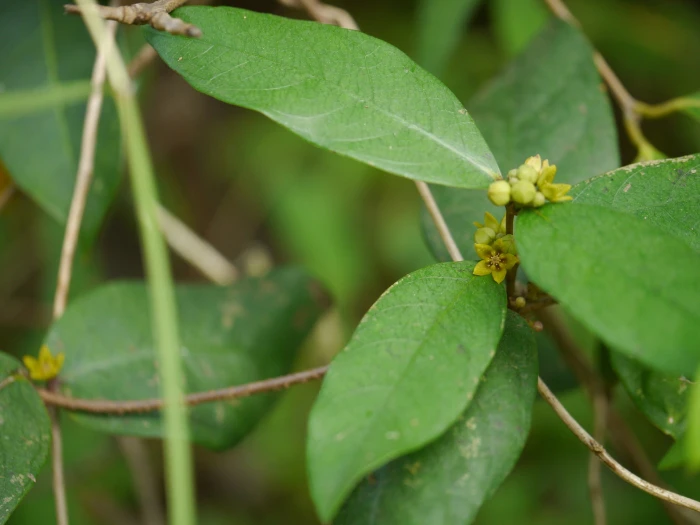Indian Sarsaparilla
(Hemidesmus indicus)
Indian Sarsaparilla (Hemidesmus indicus)
/
/

© Dinesh Valke
CC BY-SA 4.0
Image By:
© Dinesh Valke
Recorded By:
Copyright:
CC BY-SA 4.0
Copyright Notice:
Photo by: © Dinesh Valke | License Type: CC BY-SA 4.0 | License URL: http://creativecommons.org/licenses/by-sa/4.0/ | Uploader: dineshvalke | Publisher: iNaturalist |

























Estimated Native Range
Climate Requirements
| • Precipitation | 49" - 58" |
| • High Temp. | 91°F - 104°F |
| • Low Temp. | 53°F - 71°F |
Summary
Hemidesmus indicus, commonly known as Indian sarsaparilla, is a perennial, twining subshrub native to the forests, grasslands, and riverbanks of South Asia, including India, Sri Lanka, and Myanmar. It typically grows to a height of 1-2 meters with slender stems. The plant features woody, aromatic roots and has elliptic-oblong leaves that are green and glossy. The small, inconspicuous flowers are greenish on the outside and purplish inside, appearing in clusters known as sub-sessile axillary cymes. Flowering occurs from October to December, and while the flowers are not particularly showy, they are interesting upon close inspection.
Indian sarsaparilla is valued for its fragrant roots, which are used to flavor beverages like the traditional nannari sharbat. In cultivation, it prefers semi-shaded conditions, reflecting its natural habitat under the forest canopy. It thrives in well-drained, loamy soils and requires regular watering, especially during dry periods. The plant has a long history of use in Ayurvedic medicine, where it is employed to treat a variety of ailments such as fever, digestive issues, and skin diseases. It is also known for its cooling properties and is sometimes used in gardens as a ground cover or trained on trellises for its attractive foliage. Gardeners should be aware that it may require support to maintain the desired form, and it can be susceptible to pests like aphids and spider mites.CC BY-SA 4.0
Indian sarsaparilla is valued for its fragrant roots, which are used to flavor beverages like the traditional nannari sharbat. In cultivation, it prefers semi-shaded conditions, reflecting its natural habitat under the forest canopy. It thrives in well-drained, loamy soils and requires regular watering, especially during dry periods. The plant has a long history of use in Ayurvedic medicine, where it is employed to treat a variety of ailments such as fever, digestive issues, and skin diseases. It is also known for its cooling properties and is sometimes used in gardens as a ground cover or trained on trellises for its attractive foliage. Gardeners should be aware that it may require support to maintain the desired form, and it can be susceptible to pests like aphids and spider mites.CC BY-SA 4.0
Plant Description
- Plant Type: Vine
- Height: 0.5-1 feet
- Width: 2-3 feet
- Growth Rate: Slow, Moderate
- Flower Color: Green, Purple
- Flowering Season: Spring, Summer, Fall
- Leaf Retention: Deciduous
Growth Requirements
- Sun: Full Sun, Part Shade
- Water: Medium
- Drainage: Fast, Medium
Common Uses
Edible*Disclaimer: Easyscape's listed plant edibility is for informational use. Always verify the safety and proper identification of any plant before consumption., Fragrant, Low Maintenance
Natural Habitat
Forests, grasslands, and riverbanks of South Asia
Other Names
Common Names: Anantmool
Scientific Names: Hemidesmus indicus, Cosmostigma racemosa var. glandulosa, Hemidesmus indicus, Hemidesmus indicus, Hemidesmus indicus, Hemidesmus indicus var. pubescens, Hemidesmus pubescens, Hemidesmus wallichii, Hemidesmus wallichii
GBIF Accepted Name: Hemidesmus indicus